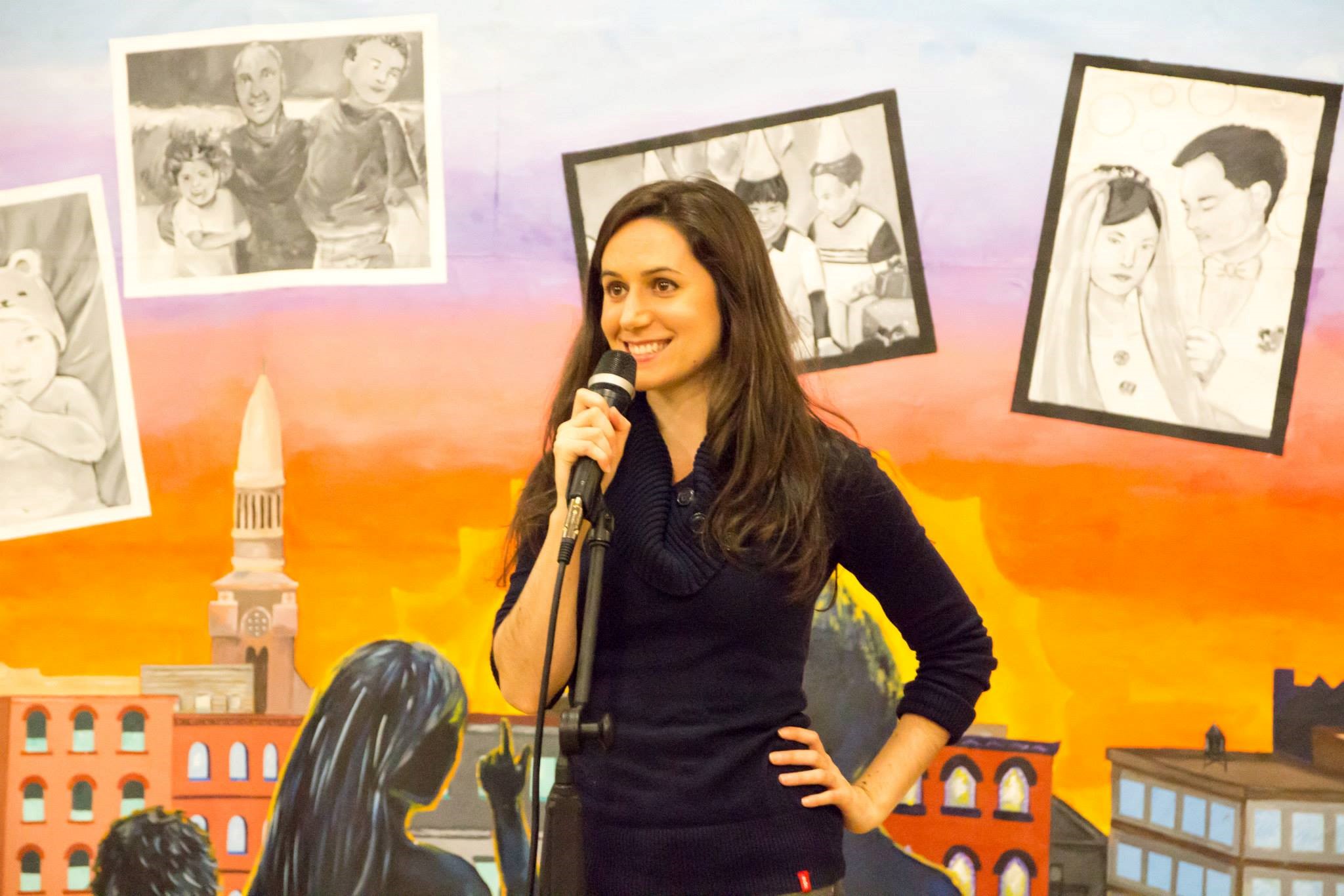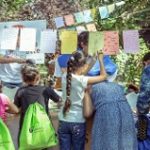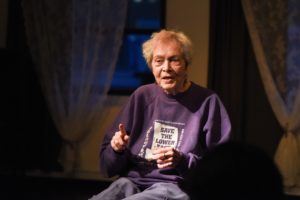I met Bridget Bartolini in 2013 at an event curated by Queens poet, Audrey Dimola at the Queens Council of the Arts. After the performance of a collective of poets representing my event Canvas of Words, she approached me and inquire if perhaps we could in a near future work together; we exchanged business cards and since then we have worked together in different projects and supported each other’s efforts to highlight the vitality of the arts in Queens, our home borough.
This past December I had the opportunity to share my story of love for Richmond Hill at one of her events through the meaning of home and the immigrant experience.
Bridget is a sweet and warm soul but also a relentless activist who works tirelessly to keep the stories of our neighborhoods alive through her organization The Five Boro Story Project.
Today, I sit with her to talk about the work she does that some of you are familiar with and to share how she is fighting gentrification one borough at a time through storytelling.
WA: Tell us about Bridget, where were you born, who are your inspirations?
BB: I was born and raised in South Richmond Hill, Queens. In 2013, I created a program called the Five Boro Story Project to bring New Yorkers together through sharing true stories and art inspired by our neighborhoods. We travel throughout the five boroughs producing events that connect New Yorkers to our neighbors and to the places where we live.
My two biggest inspirations have been:
* Professor Hope Leichter, who was my advisor when I was getting my Masters degree in Family and Community Education. Her influence helped me come up with the idea for the Five Boro Story Project. From Hope I learned about storytelling: how the act of sharing personal stories helps us move beyond simplistic conceptions of other people and places to gain deeper understanding of others, and how storytelling is fundamental to the way we make sense of the world. I realized storytelling is an incredibly powerful way to quickly build meaningful connections between people.
* The Laundromat Project, an incredible organization that supports socially engaged artists. I had a fellowship with them around the time I launched the Five Boro Story Project, and learned about socially engaged art and cultural organizing from them. Before the fellowship I had never heard of these terms, and I had a very narrow conception of what an “artist” is – I thought it’s someone who paints pictures, or sculpts sculptures. I didn’t think that the work I was doing engaging communities in storytelling was “art”, until that fellowship. It opened my world to discover that what I had been doing intuitively has a definition and a framework. Their values helped me shape the FBSP into what it is, particularly the values of deep listening, neighborliness, doing work propelled by love, and building relationships and trust slowly in the communities where you work.
WA: How did you come up with the concept of “Five Boro Story Project”? What is the mission behind it?
BB: A big part of my inspiration for the Five Boro Story Project came from my experiences growing up in South Richmond Hill. This is a neighborhood where “making it” means getting out. Naturally, I grew up dreaming of moving somewhere “nice” like Manhattan. But at some point when I got older, I wondered, what if instead of putting our energy into figuring out how to jump ship, we had more opportunities to build on and appreciate what’s already here? From the time I was a high school student, I’d hop on the train and go to Manhattan to have fun. But why does enjoying the city’s culture have to entail a long commute? Why don’t I enjoy more fun cultural programs in my own neighborhood?
These questions got me thinking. I wanted to do produce public events that bring people together, to get us more involved in the places where we live, and help us take pride in where we’re from. This is important because although a lot of us in the outer boroughs are proud, at the same time we often internalize some of the pervasive negative stereotypes about the places where we live. And I feel in our daily lives we have too few opportunities for positive and meaningful interactions with our neighbors.
I knew I wanted to create fun, enriching, accessible public programs especially for New Yorkers like myself and my family, who live far from the city center and don’t have much leisure time or disposable income. Especially in the outer boroughs.
So the Five Boro Story Project was born. We produce free public events with curated performances of true life stories, songs, poems, and other art inspired by our neighborhoods. We hold open mics and community discussions. We also organize small, intimate story-sharing workshops and other community activities.
In the beginning what I wanted to do was produce fun community-building events. As I’ve been doing the Five Boro Story Project, it has evolved to focus more on social justice, creating a platform for community organizers and activists to share their stories. The events help us build relationships with neighbors so we can get organized around the issues we care about. We primarily do events in neighborhoods where there aren’t a ton of cultural programs happening-to boost neighborhood love, and in gentrifying neighborhoods where the local history and culture is being erased- to push back against that erasure.
Our mission is to strengthen community connections, preserve personal narratives, challenge negative perceptions of the outer boroughs and marginalized areas, resist erosion of local history and culture, and celebrate the diverse neighborhoods and people of NYC.
WA: When did you launch it?
BB:I launched the Five Boro Story Project in April 2013.
WA: Why is it important to you personally to do this?
BB: In Japanese there’s a concept called “ikigai.” It can be translated as your life’s purpose, or reason for being. It’s the intersection of what you love, what you’re good at, what the world needs, and what you can be paid for. The Five Boro Story Project is my ikigai (except for the paying part – I still need my day job!)
It’s incredibly rewarding because I do see it making a positive impact. The feedback I get from people shows that the events increase people’s interest in the history and culture of their neighborhood; they sometimes meet new friends and collaborators; and most gratifying to me is when people share how participating in a program changed negative ideas they’ve internalized about their own neighborhood. People have said things like, “Tonight proved to me that we aren’t this backwards place that people like to think we are,” which shows me how deeply stereotypes can impact us, and how presenting a positive counterpoint to those stereotypes can be really powerful.
WA: What are the long term goals for Five Boro Story Project?
BB: I plan to keep working towards the same goals, but to do more long-term, sustained programming in neighborhoods. Continuing programs will have a more lasting impact than one-time events.
WA: What have been the challenges you faced for the execution of your programming as far as spaces, funding, support from the local government.
BB: I’ve been doing it with very little funding, on a shoestring budget. I actually launched it with no budget. At our first events we just passed around a bucket for donations, and split whatever we made between the storytellers. Now all of our programs are supported by small grants, and by organizations that invite us to do events in their spaces. For each and every event I partner with amazing people and organizations in the neighborhood. We’ve been lucky to have incredible spaces invite us in to do programs. But I’m the one person who is the common thread in all the programming, and there is only so much one person can do while juggling a full-time job! We could do a lot more with more funding.
WA: Since I’ve known you, you have been very outspoken about Gentrification in our neighborhoods, why is this so important to you? It seems to be inevitable, is there anything positive about gentrification? How can storytelling be a tool to fight against it?
BB: Yes, I think gentrification and displacement constitute one of the biggest threats to our city. I worry about the future of New York. I worry about my ability to stay here, if me and my family and loved ones will be pushed out by the insane rents.
But I don’t think the progression of gentrification is inevitable. It’s not a naturally occurring phenomenon; it’s the result of policies. It can feel overwhelming, like this huge tsunami that’s coming to crush us all. But how far can it go?
I hope not much further!
While I worry about New York city becoming a place where only rich people live, I have a lot of hope that won’t come to pass. I see people organizing and resisting, doing things like starting community land trusts.
And I do believe storytelling is an important tool in the fight against gentrification. I actually learned about community land trusts from Fran Goldin, who told a story in a Lower East Side storytelling event, LES Is More. She was 91 years old at the time. She told how she fought Robert Moses and established NYC’s first community land trust. It took her 50 years!! But she did it, and created a blueprint we can follow.
When we hear stories from elders about the not-too-distant past in New York City, it shows us alternatives to the way things are now. That’s valuable because it helps us learn from the past – we can see what we want to preserve, and what needs to be changed – and it helps us imagine alternatives for the future we want to see. Maxine Greene (another inspiration) defined imagination as “the capacity to think of things as if they could be otherwise.” Imagining something is the first step before you build it. We can shape our city. As Audre Lorde said, “That you can’t fight City Hall is a rumor being spread by City Hall.”
WA: As a woman, daughter of immigrants, who grew up in Richmond Hill which is in itself a very diverse neighborhood, your thoughts on the importance of diversity and representation.
BB: Diversity is what makes New York City great. Diversity keeps the city fresh. And Queens is the most diverse borough of all! I feel so lucky to have grown up here. The diversity I grew up with shaped who I am and made me open-minded.
Another negative impact of gentrification is the loss of diversity. Diversity in the countries we come from, in our perspectives, cultures, languages, ethnicities, sexualities, classes, and also diversity in terms of thought. Gentrification leads to homogeneity not only because neighborhoods become whiter and wealthier, but there’s also homogeneity in the way people think.
I very rarely see the New York City that I know represented in the media. More often you see shows like “Girls” – I couldn’t watch past the first episode of that show because the only person of color was a homeless man asking for money. That pissed me off. That’s not New York City!! New York is multiethnic, multilingual, multi-everything!
I do feel accountable to represent neighborhoods as they really are in the storytelling programs that I produce. Of course it’s not possible to represent all of one neighborhood in any given event, because even within one neighborhood there are so many different realities, but I am very mindful of this. We regular New Yorkers deserve to see ourselves, not just the stories of transplants, or extremes of glamour or poverty. One of those three things tend to be the dominant narratives you see about New York City. It’s ironic that we don’t see more stories that reflect the majority of people in our city.
WA: What’s next for Bridget and the Five Boro Story Project?
BB: Since April we’ve been working on a series called “Almost Home/ Casi Llegando a Casa” which focuses on stories of gentrification and immigration in the neighborhoods of Jackson Heights, Elmhurst, and Corona. The culminating event is coming up in November or December – date to be announced soon!
I’ve been doing these series now where we have people write love notes to their neighborhoods and couple that with storytelling – we’ve done Richmond Hill Love Letter, South Bronx Love Letter, and LIC & Astoria Love Letter. More to come!
If you want to connect with Bridget and The Five Boro Story Project, here are the links:
Facebook: https://www.facebook.com/thefiveborostoryproject/
Instagram: @fiveborostoryproject
Twitter: @Fiveborostories
YouTube: https://www.youtube.com/fiveborostoryproject
 Wendy Angulo Productions
Wendy Angulo Productions









